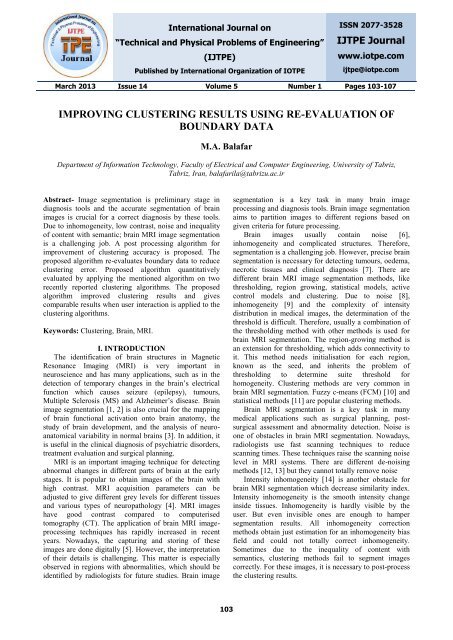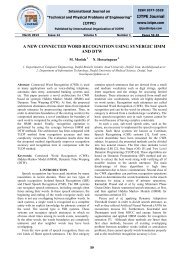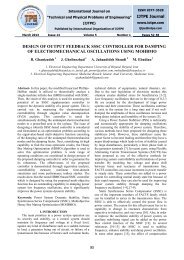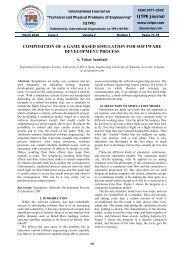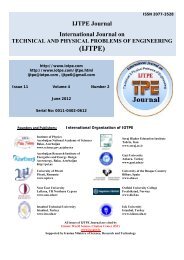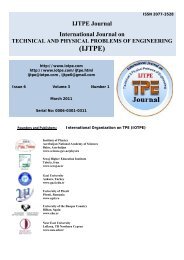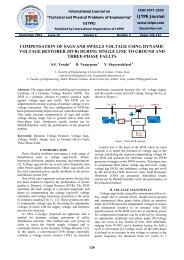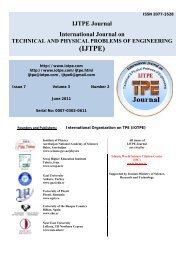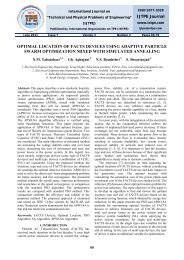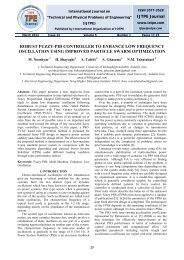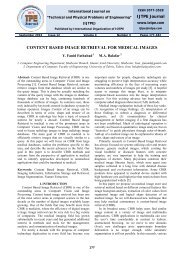15-IJTPE-Issue14-Vol5-No1... - iotpe
15-IJTPE-Issue14-Vol5-No1... - iotpe
15-IJTPE-Issue14-Vol5-No1... - iotpe
Create successful ePaper yourself
Turn your PDF publications into a flip-book with our unique Google optimized e-Paper software.
International Journal on<br />
“Technical and Physical Problems of Engineering”<br />
(<strong>IJTPE</strong>)<br />
Published by International Organization of IOTPE<br />
ISSN 2077-3528<br />
<strong>IJTPE</strong> Journal<br />
www.<strong>iotpe</strong>.com<br />
ijtpe@<strong>iotpe</strong>.com<br />
March 2013 Issue 14 Volume 5 Number 1 Pages 103-107<br />
IMPROVING CLUSTERING RESULTS USING RE-EVALUATION OF<br />
BOUNDARY DATA<br />
M.A. Balafar<br />
Department of Information Technology, Faculty of Electrical and Computer Engineering, University of Tabriz,<br />
Tabriz, Iran, balafarila@tabrizu.ac.ir<br />
Abstract- Image segmentation is preliminary stage in<br />
diagnosis tools and the accurate segmentation of brain<br />
images is crucial for a correct diagnosis by these tools.<br />
Due to inhomogeneity, low contrast, noise and inequality<br />
of content with semantic; brain MRI image segmentation<br />
is a challenging job. A post processing algorithm for<br />
improvement of clustering accuracy is proposed. The<br />
proposed algorithm re-evaluates boundary data to reduce<br />
clustering error. Proposed algorithm quantitatively<br />
evaluated by applying the mentioned algorithm on two<br />
recently reported clustering algorithms. The proposed<br />
algorithm improved clustering results and gives<br />
comparable results when user interaction is applied to the<br />
clustering algorithms.<br />
Keywords: Clustering, Brain, MRI.<br />
I. INTRODUCTION<br />
The identification of brain structures in Magnetic<br />
Resonance Imaging (MRI) is very important in<br />
neuroscience and has many applications, such as in the<br />
detection of temporary changes in the brain’s electrical<br />
function which causes seizure (epilepsy), tumours,<br />
Multiple Sclerosis (MS) and Alzheimer’s disease. Brain<br />
image segmentation [1, 2] is also crucial for the mapping<br />
of brain functional activation onto brain anatomy, the<br />
study of brain development, and the analysis of neuroanatomical<br />
variability in normal brains [3]. In addition, it<br />
is useful in the clinical diagnosis of psychiatric disorders,<br />
treatment evaluation and surgical planning.<br />
MRI is an important imaging technique for detecting<br />
abnormal changes in different parts of brain at the early<br />
stages. It is popular to obtain images of the brain with<br />
high contrast. MRI acquisition parameters can be<br />
adjusted to give different grey levels for different tissues<br />
and various types of neuropathology [4]. MRI images<br />
have good contrast compared to computerised<br />
tomography (CT). The application of brain MRI imageprocessing<br />
techniques has rapidly increased in recent<br />
years. Nowadays, the capturing and storing of these<br />
images are done digitally [5]. However, the interpretation<br />
of their details is challenging. This matter is especially<br />
observed in regions with abnormalities, which should be<br />
identified by radiologists for future studies. Brain image<br />
segmentation is a key task in many brain image<br />
processing and diagnosis tools. Brain image segmentation<br />
aims to partition images to different regions based on<br />
given criteria for future processing.<br />
Brain images usually contain noise [6],<br />
inhomogeneity and complicated structures. Therefore,<br />
segmentation is a challenging job. However, precise brain<br />
segmentation is necessary for detecting tumours, oedema,<br />
necrotic tissues and clinical diagnosis [7]. There are<br />
different brain MRI image segmentation methods, like<br />
thresholding, region growing, statistical models, active<br />
control models and clustering. Due to noise [8],<br />
inhomogeneity [9] and the complexity of intensity<br />
distribution in medical images, the determination of the<br />
threshold is difficult. Therefore, usually a combination of<br />
the thresholding method with other methods is used for<br />
brain MRI segmentation. The region-growing method is<br />
an extension for thresholding, which adds connectivity to<br />
it. This method needs initialisation for each region,<br />
known as the seed, and inherits the problem of<br />
thresholding to determine suite threshold for<br />
homogeneity. Clustering methods are very common in<br />
brain MRI segmentation. Fuzzy c-means (FCM) [10] and<br />
statistical methods [11] are popular clustering methods.<br />
Brain MRI segmentation is a key task in many<br />
medical applications such as surgical planning, postsurgical<br />
assessment and abnormality detection. Noise is<br />
one of obstacles in brain MRI segmentation. Nowadays,<br />
radiologists use fast scanning techniques to reduce<br />
scanning times. These techniques raise the scanning noise<br />
level in MRI systems. There are different de-noising<br />
methods [12, 13] but they cannot totally remove noise<br />
Intensity inhomogeneity [14] is another obstacle for<br />
brain MRI segmentation which decrease similarity index.<br />
Intensity inhomogeneity is the smooth intensity change<br />
inside tissues. Inhomogeneity is hardly visible by the<br />
user. But even invisible ones are enough to hamper<br />
segmentation results. All inhomogeneity correction<br />
methods obtain just estimation for an inhomogeneity bias<br />
field and could not totally correct inhomogeneity.<br />
Sometimes due to the inequality of content with<br />
semantics, clustering methods fail to segment images<br />
correctly. For these images, it is necessary to post-process<br />
the clustering results.<br />
103
International Journal on “Technical and Physical Problems of Engineering” (<strong>IJTPE</strong>), Iss. 14, Vol. 5, No. 1, Mar. 2013<br />
II. BACKGROUND<br />
A modified Gaussian Mixture GMM (EM1) [11] was<br />
introduced by incorporating neighbourhood information<br />
in the likelihood function and EM steps.<br />
log( L( | X )) log p( x | ) log((1- ).<br />
M<br />
<br />
t t<br />
j j i j<br />
j1<br />
Ki[ L]<br />
rKi[1]<br />
i1<br />
. [ p ( x | ) * p])<br />
1<br />
t<br />
p p j ( xr | j )<br />
L<br />
N<br />
<br />
i<br />
N<br />
<br />
i1<br />
where x r represents a neighbour of the pixel x i ,<br />
K i [1],…,K i [L] denotes the set of neighbours of pixel x i<br />
which is determined by a window centred on x i , L is the<br />
number of neighbours, p is the average of distribution<br />
t<br />
values for neighbours of pixel x i , j denotes the<br />
distribution parameters for the jth component at iteration<br />
t<br />
t, j denotes the mixture coefficient of component j at<br />
iteration t, and parameter determines the weight of the<br />
neighbourhood information and it is considered equal to<br />
the variance of noise.<br />
A modified EM, which is named as EM1, is proposed<br />
to obtain the modified GMM parameters.<br />
p( j | x , )<br />
<br />
t1<br />
j<br />
<br />
Ki[ L]<br />
t t <br />
t<br />
j[(1 ) p j ( xi | j ).* p j ( xr | j )]<br />
L<br />
t<br />
rKi[1]<br />
i j <br />
M Ki[ L]<br />
t t <br />
t<br />
j p j xi j p j xr j<br />
j1 L<br />
rKi[1]<br />
<br />
t1<br />
k<br />
N<br />
<br />
[(1 ) ( | ).* ( | )]<br />
Ki[ L]<br />
<br />
t<br />
((1 ) x x ) p( j | x , )<br />
<br />
i r i<br />
i1 L<br />
rKi[1]<br />
N<br />
t<br />
p( j | xi<br />
, )<br />
i1<br />
<br />
Ki[ L]<br />
rKi[1]<br />
N<br />
<br />
i1<br />
1<br />
p( j | x , )<br />
i1<br />
t1 t1<br />
T<br />
i j xi j<br />
.[(1 )( x )( ) <br />
{ p( j | x , ).<br />
<br />
t1 t1<br />
T<br />
( xr j )( xr j<br />
) ]}<br />
L<br />
i<br />
t<br />
N<br />
<br />
Another improvement was introduced (EM2) [<strong>15</strong>].<br />
The x i (average of neighbouring pixels around x i ) is<br />
calculated prior to clustering.<br />
log( L( | X )) log p( x | )<br />
<br />
N<br />
<br />
i1<br />
N M<br />
<br />
t t t<br />
j j i j j i j<br />
i1 j1<br />
log( [(1 ) p ( x | ) p ( x | )])<br />
p( j | x , ) <br />
i<br />
t t t<br />
t j j i j j j<br />
i j M<br />
<br />
t t t<br />
j j i j j j<br />
j1<br />
[(1 ) p ( x | ) p ( x | )]<br />
[(1 ) p ( x | ) p ( x | )]<br />
i<br />
t<br />
(1)<br />
(2)<br />
(3)<br />
(4)<br />
(5)<br />
(6)<br />
N<br />
t<br />
((1 ) xi xi ) p( j | xi<br />
, )<br />
t1 i1<br />
j <br />
(7)<br />
N<br />
t<br />
p( j | xi<br />
, )<br />
i1<br />
N<br />
t1<br />
1<br />
t<br />
<br />
{ ( | , ).<br />
k N p j xi<br />
<br />
t i1<br />
p( j | xi<br />
, )<br />
(8)<br />
i1<br />
<br />
<br />
t1 t1 T t1 t1<br />
T<br />
i j i j j j<br />
.((1 )( x )( x ) ( x )( x ) )}<br />
Sometimes, due to inhomogeneity, low contrast, noise<br />
and inequality of content with semantics, automatic<br />
methods fail to segment images correctly. Therefore, for<br />
these images, it is necessary to use user-interaction to<br />
correct a method’s error. However, robust semi-automatic<br />
methods can be developed in which user-interaction is<br />
minimized.<br />
A user-interaction algorithm is introduced [<strong>15</strong>].<br />
Sometimes, a clustered image either has pixels from two<br />
or more tissues in one cluster or pixels from one tissue in<br />
two or more clusters. To solve this problem, the user<br />
selects clusters containing several tissues to be reclustered<br />
into two sub-clusters. This process continues<br />
until the user is satisfied. This means that the quality of<br />
segmentation depends on the user. Then, to solve the<br />
problem of several clusters for one tissue, the user selects<br />
the clusters for each tissue.<br />
III. METHODS<br />
In this section, a new post-processing process which<br />
re-evaluates boundary data to improve clustering results<br />
is proposed. Proposed algorithm re-clusters each cluster<br />
to reduce miss clustering rate.<br />
A. Re-Evaluation of Boundary Data<br />
User-interaction improves clustering performance but<br />
makes clustering algorithms subjective and timeconsuming.<br />
Also, algorithms lose their automatic nature<br />
and it would be almost impossible to segment large<br />
collections of image volumes using user-interaction. In<br />
order to make algorithms automatic, but in the meantime<br />
improve segmentation results, boundary data in clusters<br />
are utilized. To improve clustering without userinteraction,<br />
the boundary data in each cluster is reevaluated.<br />
To do that, each cluster is re-clustered. Figure<br />
1 demonstrates three clusters and their sub-clusters.<br />
Figure 1. Three clusters and their sub-clusters,<br />
underlined numbers are used for core parts<br />
In Figure 1, sub-clusters with underlined numbers<br />
represent the core parts of each cluster and other subclusters<br />
are boundary parts. In order to specify the<br />
situation of boundary data, core parts compete for<br />
boundary parts. The steps of this algorithm are listed as<br />
follows:<br />
104
International Journal on “Technical and Physical Problems of Engineering” (<strong>IJTPE</strong>), Iss. 14, Vol. 5, No. 1, Mar. 2013<br />
The input image is clustered to the n clusters, where n<br />
is the number of target classes (here, the 4 clusters are<br />
considered. Three represent the three tissues in the brain<br />
while one is for the background). The output is the<br />
clustered image.<br />
Each cluster, except the background, is re-clustered.<br />
In each cluster, the number of neighbouring clusters<br />
specifies the number of boundary parts. Also, each cluster<br />
will have one core part. Cluster number 2 is situated<br />
between two clusters. Therefore, it is clustered into three<br />
sub-clusters. However, clusters numbers 1 and 3 have just<br />
one neighbouring cluster and are clustered into two subclusters.<br />
Cluster number 1 is clustered into two subclusters,<br />
numbers 11 and 12. Cluster number 2 is<br />
clustered into three sub-clusters, numbers 21, 22 and 23.<br />
Also, cluster number 3 is clustered into two sub-clusters,<br />
numbers 31 and 32. The clusters and sub clusters are<br />
ordered based on their mean intensity values.<br />
In each cluster, the sub-clusters in the neighbourhood<br />
of other clusters are considered as boundary parts while<br />
the other sub-clusters are the core parts. The sub-clusters<br />
11, 22 and 32 are considered as the core part and the<br />
other sub-clusters are the boundary data for clusters<br />
number 1, 2 and 3, respectively.<br />
The core parts of the neighbourhood clusters compete<br />
for their boundary parts. The core parts 11 and 22<br />
compete for boundary parts 12 and 21. Steps 5 and 7 are<br />
performed to specify the situation for boundary parts 12<br />
and 21.<br />
The abstract distances of centre of each boundary part<br />
from the centres of the competing core parts are<br />
calculated. The core part with less distance from a<br />
boundary part is winner. The abstract difference between<br />
the distances of a boundary part from two competing core<br />
parts represents the winning degree for that boundary<br />
part. For example, Figure 2 demonstrates the distances<br />
between the core and boundary parts of clusters number 1<br />
and 2. The abstract distances of boundary part 12 from<br />
the centres of the competing core parts (11 and 22) are<br />
denoted by d 1 and d 2 . The core part with less distance<br />
from the boundary part centre is the winner. In<br />
competition for boundary part 12, if d 1
International Journal on “Technical and Physical Problems of Engineering” (<strong>IJTPE</strong>), Iss. 14, Vol. 5, No. 1, Mar. 2013<br />
Figure 5. The similarity index of EM1 with and without post-processing<br />
when applied on 20 real images<br />
Figure 3. Flowchart for the re-evaluation of boundary data<br />
Figure 6. The similarity index of EM-2 with and without postprocessing<br />
when applied on 20 real images<br />
Figure 4. Two sub-process in follow chart for re-evaluation of boundary<br />
data<br />
V. CONCLUSIONS<br />
In this paper, an automatic post processing algorithm<br />
has been introduced. The performance of the proposed<br />
algorithm on two recently reported clustering algorithm is<br />
investigated. Sometimes due to the inequality of content<br />
with semantics, clustering methods fail to segment<br />
images correctly. For these images, it is necessary to<br />
post-process the clustering results.<br />
Figure 7. The average similarity index of the proposed algorithm when<br />
applied on 20 real images<br />
In last research a user-interaction algorithm for the<br />
post-processing of clustering results are presented. The<br />
algorithm uses user-interaction to improve clustering<br />
results. In this paper, a new post processing algorithm is<br />
proposed which improves clustering results by the reevaluation<br />
of boundary data in each cluster. The<br />
similarity index, r is used to evaluate algorithms.<br />
Experiments demonstrate the effectiveness of the<br />
proposed algorithm on improving clustering results in<br />
terms of similarity index, r.<br />
106
International Journal on “Technical and Physical Problems of Engineering” (<strong>IJTPE</strong>), Iss. 14, Vol. 5, No. 1, Mar. 2013<br />
The focus of this research is on re-clustering on each<br />
cluster. In future, we consider doing research for<br />
changing the proposed post processing algorithm to<br />
consider each boundary point and utilise optimizing<br />
algorithms to improve clustering results.<br />
REFERENCES<br />
[1] M.A. Balafar, “Gaussian Mixture Model Based<br />
Segmentation Methods for Brain MRI Images”, Artif.<br />
Intell. Rev., pp. DOI 10.1007/s10462-012-9317-3, 2012.<br />
[2] M.A. Balafar, “Fuzzy C-Mean Based Brain MRI<br />
Segmentation Algorithms”, Artif. Intell. Rev., pp. DOI<br />
10.1007/s10462-012-9318-2, 2012.<br />
[3] X. Han, B. Fischl, “Atlas Renormalization for<br />
Improved Brain MR Image Segmentation across Scanner<br />
Platforms”, IEEE Transactions on Medical Imaging, Vol.<br />
26, p. 479, 2007.<br />
[4] D. Tian, L. Fan, “A Brain MR Images Segmentation<br />
Method Based on SOM Neural Network”, 1st<br />
International Conference on Bioinformatics and<br />
Biomedical Engineering, pp. 686-689, 2007.<br />
[5] P.L. Chang, W.G. Teng, “Exploiting the Self-<br />
Organizing Map for Medical Image Segmentation”, 20th<br />
IEEE International Symposium on Computer Based<br />
Medical Systems, pp. 281-288, 2007.<br />
[6] P. Coupe, J.V. Manjon, E. Gedamu, D. Arnold, M.<br />
Robles, D.L. Collins, “Robust Rician Noise Estimation<br />
for MR Images”, Medical Image Analysis, Vol. 14, pp.<br />
483-493, 2010.<br />
[7] L.O. Hall, A.M. Bensaid, L.P. Clarke, R.P.<br />
Velthuizen, M.S. Silbiger, J.C. Bezdek, “A Comparison<br />
of Neural Network and Fuzzy Clustering Techniques in<br />
Segmenting Magnetic Resonance Images of the Brain”,<br />
IEEE Transactions on Neural Networks, Vol. 3, pp. 672-<br />
682, 1992.<br />
[8] M.A. Balafar, “New Spatial Based MRI Image De-<br />
Noising Algorithm”, Artifitial Intelligence Review,<br />
DOI:10.1007/s10462-011-9268-0, pp. 1-11, 2011.<br />
[9] M.A. Balafar, A.R. Ramli, S. Mashohor, “A New<br />
Method for MR Grayscale Inhomogeneity Correction”,<br />
Artificial Intelligence Review, Springer, Vol. 34, pp. 195-<br />
204, 2010.<br />
[10] S. Krinidis, V. Chatzis, “A Robust Fuzzy Local<br />
Information C-Means Clustering Algorithm”, IEEE<br />
Transactions on Image Processing, Vol. 19, pp. 1328-<br />
1337, 2010.<br />
[11] M.A. Balafar, A.R. Ramli, S. Mashohor, “Medical<br />
Brain Magnetic Resonance Image Segmentation Using<br />
Novel Improvement for Expectation Maximizing”,<br />
Neurosciences, Vol. 16, pp. 242-247, 2011.<br />
[12] C.S. Anand, J.S. Sahambi, “Wavelet Domain Non-<br />
Linear Filtering for MRI Denoising”, Magnetic<br />
Resonance Imaging, Vol. 28, pp. 842-861, 2010.<br />
[13] M.A. Balafar, “Review of Noise Reducing<br />
Algorithms for Brain MRI Images”, International Journal<br />
on Technical and Physical Problems of Engineering<br />
(<strong>IJTPE</strong>), Issue 13, Vol. 4, No. 4, pp. 54-59, December<br />
2012.<br />
[14] M.A. Balafar, “Review of Intensity Inhomogeneity<br />
Correction Methods for Brain MRI Images”, Issue 13,<br />
Vol. 4, No. 4, pp. 60-66, December 2012.<br />
[<strong>15</strong>] M.A. Balafar, “Spatial Based Expectation<br />
Maximizing (EM)”, Diagnostic Pathology, pp. 6-103,<br />
2011.<br />
BIOGRAPHY<br />
Mohammad Ali Balafar was born in<br />
Tabriz, Iran, in June 1975. He received<br />
the Ph.D. degree in IT in 2010.<br />
Currently, he is an Assistant Professor.<br />
His research interests are in artificial<br />
intelligence and image processing. He<br />
has published 11 journal papers and 4<br />
book chapters.<br />
107


